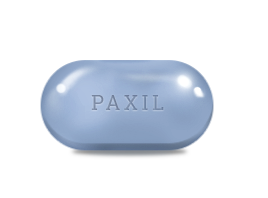Buy Paxil Online

Paxil, known scientifically as paroxetine, enters the medical scene as a member of the selective serotonin reuptake inhibitor (SSRI) family. Its primary role in the pharmaceutical realm is to rectify imbalances in the brain's serotonin levels, a neurotransmitter pivotal for mood regulation. The elevation of serotonin levels in the synaptic cleft, achieved by hindering its reuptake into the presynaptic cell, lays the groundwork for Paxil's therapeutic effects. This mechanism of action positions Paxil as a potent ally in the battle against a spectrum of mental health disorders, including major depressive disorder, generalized anxiety disorder, panic disorder, and social anxiety disorder, to name a few.
Unveiling Paxil: What Exactly Is It?
The introduction of Paxil into a patient's treatment regimen is not a decision made lightly. It undergoes meticulous consideration, often emerging as a viable option when other treatments have failed to yield sufficient results. The therapeutic benefits offered by Paxil, from ameliorating symptoms of depression to restoring daily functioning, are testament to its significance in psychiatric medicine. However, it is paramount to approach its administration with an understanding of the precise dosage and treatment duration, tailored to the individual's specific condition and response to therapy.
| Drug Classification | Primary Use | Mode of Action |
|---|---|---|
| Selective Serotonin Reuptake Inhibitor (SSRI) | Treatment of major depressive disorder, generalized anxiety disorder, panic disorder, and social anxiety disorder | Increases serotonin levels in the brain by inhibiting its reuptake into the presynaptic cell |
While Paxil represents a beacon of hope for many grappling with mental health challenges, its incorporation into treatment plans underscores the necessity for a comprehensive understanding of its pharmacological profile. Such knowledge ensures that both healthcare providers and patients are well-equipped to maximize its benefits while preemptively addressing any potential adverse effects. This fundamental grasp of Paxil's identity not only demystifies its application in clinical settings but also empowers individuals to navigate their path to recovery with an informed perspective.
Paxil: How It Works in the Brain
Understanding the mechanism by which Paxil operates within the brain unveils a fascinating journey into the intricacies of neural chemistry and its impact on mood and emotion. Paxil, a selective serotonin reuptake inhibitor (SSRI), targets the neurotransmitter serotonin, a key player in the regulation of mood, anxiety, and happiness. By inhibiting the reuptake of serotonin in the brain, Paxil allows for an increased concentration of this neurotransmitter in the synaptic gap between neurons. This abundance of serotonin enhances neurotransmission, leading to improved mood and amelioration of depressive symptoms. What sets Paxil apart is its specificity in targeting serotonin reuptake without significantly affecting other neurotransmitters, making its action somewhat precise in the realm of antidepressants.

Delving deeper into the neural mechanisms, it's fundamental to recognize the adaptability of the brain's biochemical landscape in response to Paxil. Over time, the sustained increase in serotonin levels prompts the brain to adjust by altering receptor densities and neuronal circuitry, a process which contributes to the therapeutic effects of the medication. This modulation of the brain's biochemistry exemplifies the dynamic nature of psychiatric pharmacotherapy and underscores the importance of adherence to prescribed treatment regimens for maximizing the benefits of Paxil.
However, while the focus predominantly rests on serotonin, the overarching effects of Paxil in enhancing neuroplasticity and reducing neuroinflammation hint at a more complex interplay of mechanisms beyond mere serotonin reuptake inhibition. This broader perspective necessitates continuous research to further elucidate the multi-dimensional impact of Paxil on the brain, reinforcing the importance of a scientific and informed approach in the prescription and use of this medication in the battle against depression.
The Common Side Effects of Paxil Revealed
Paxil, a prevalent antidepressant in the class of drugs known as SSRIs (Selective Serotonin Reuptake Inhibitors), has been a beacon of hope for those grappling with depression, anxiety, and other mood disorders. However, like all potent medications, it comes with its share of potential side effects that patients and healthcare providers must consider. Commonly reported side effects include nausea, drowsiness, dizziness, and insomnia, each of which stems from the drug's interaction with the brain's neurotransmitter systems. While these reactions are generally mild and tend to diminish over time, they underscore the importance of monitoring and managing the initial response to the medication carefully.
Furthermore, sexual dysfunction, weight gain, and dry mouth have also been documented as frequent side effects associated with Paxil. The alteration of serotonin levels in the brain, while beneficial for mood regulation, can inadvertently impact other bodily functions leading to these undesirable outcomes. This underscores a critical aspect of SSRIs - their wide-ranging effects on both the central nervous system and peripheral systems, necessitating a balanced approach to their use. Patients might experience changes in appetite or sleep patterns, which, though secondary, can significantly affect one's quality of life and overall wellbeing.
To navigate these side effects effectively, it is imperative for both patients and practitioners to engage in open, informed discussions about the potential impacts of Paxil. Regular follow-ups and careful dose adjustments can mitigate many of the common adverse reactions, optimizing the therapeutic benefits of the medication while minimizing discomfort. Understanding these side effects not only helps in setting realistic expectations but also empowers patients to take an active role in their treatment plan, enhancing the overall efficacy of Paxil in managing mood disorders.
Navigating Serious Side Effects: When to Worry
While Paxil (paroxetine) is a widely prescribed antidepressant that has offered relief to many suffering from mental health disorders, it's crucial for patients and healthcare providers to be vigilant about its serious side effects. Some of these adverse reactions can pose significant health risks and warrant immediate attention. Among the concerning symptoms to be on the lookout for are suicidal thoughts or actions, especially in young adults and children which is an alarming but well-documented risk associated with many antidepressants. Additionally, severe mood swings, anxiety, panic attacks, and an increase in depression severity can indicate that the medication may not be the best option for the patient.
Moreover, Paxil has been linked to rare but serious side effects that affect physical health, including serotonin syndrome, a condition that occurs when there is too much serotonin in the brain. Symptoms range from shivering and diarrhea to severe manifestations like muscle rigidity, fever, and seizures, potentially leading to life-threatening situations. Another serious condition associated with Paxil is the risk of persistent pulmonary hypertension in newborns (PPHN) when taken during pregnancy, underscoring the need for a thorough risk-benefit analysis by healthcare providers for pregnant patients.

Undoubtedly, the onset of these severe side effects necessitates a prompt medical response. Patients experiencing any such symptoms should seek immediate help from healthcare professionals. It is imperative for both patients and practitioners to maintain an open line of communication, closely monitoring any changes in behavior, physical health, or emotional well-being during the course of treatment with Paxil.
In managing these serious side effects, a tailored approach to each patient's care plan is vital. Adjusting dosages, transitioning to different medications, or incorporating therapeutic interventions like cognitive-behavioral therapy may be considered. Awareness and education on the potential side effects of Paxil play a crucial role in safeguarding patients’ health, enabling individuals to make informed decisions about their treatment in collaboration with their healthcare provider.
Paxil and Interactions: Mixing Meds with Caution
The pharmacological landscape is heavily dotted with a variety of substances, each interacting in complex ways within the human body. Paxil, a potent selective serotonin reuptake inhibitor (SSRI), is no exception. It operates by adjusting the levels of serotonin in the brain, a neurotransmitter directly linked to mood regulation. However, this delicate balance can be easily disturbed when other medications are introduced into the system. The co-administration of Paxil with other drugs necessitates a cautious approach due to the high risk of adverse drug interactions. For instance, combining Paxil with monoamine oxidase inhibitors (MAOIs), other SSRIs, or serotonin and norepinephrine reuptake inhibitors (SNRIs) can lead to serotonin syndrome, a potentially life-threatening condition characterized by symptoms such as fever, agitation, and increased heart rate.
Moreover, consuming Paxil alongside anticoagulants like warfarin, or antiplatelet drugs, could heighten the risk of bleeding, given Paxil's propensity to interfere with platelet aggregation. Similarly, the concurrent use of nonsteroidal anti-inflammatory drugs (NSAIDs) might amplify this risk, underscoring the importance of medical oversight. Patients must be vigilant and inform their healthcare providers about all medications, supplements, and over-the-counter drugs they are taking to mitigate such risks.
Additionally, the metabolism of Paxil is primarily facilitated through the cytochrome P450 2D6 enzyme system in the liver. This means that drugs competing for metabolism through this pathway can potentially lead to increased concentrations of Paxil in the blood, escalating the risk of side effects. Conversely, Paxil itself can alter the plasma levels of drugs metabolized through the same pathway, necessitating adjustments in dosages and careful monitoring by healthcare professionals.
Implementing measures to minimize these interactions involves a comprehensive review of the patient's current medications before initiating Paxil therapy. Regular follow-ups and possibly adjusting the dosages can help in managing these drug interactions effectively. Patients should be encouraged to maintain open lines of communication with their healthcare providers, reporting any unusual symptoms or reactions promptly. This proactive approach is crucial in safeguarding against the unintended consequences of mixing medications, ensuring the efficacy of Paxil while minimizing the risks to the patient's health.
Long-term Effects: Understanding Paxil's Impact
Paxil, known scientifically as paroxetine, is a Selective Serotonin Reuptake Inhibitor (SSRI) widely prescribed for the treatment of depression, anxiety disorders, and other mental health conditions. While its short-term benefits in managing these disorders are well-documented, the long-term implications of Paxil use merit careful consideration. Chronic administration of Paxil has been associated with various long-term effects that patients and healthcare providers should be aware of. Among these, weight changes, sexual dysfunction, and emotional numbing are frequently cited. These effects can profoundly impact an individual's quality of life and may persist even after the medication is discontinued.
Moreover, research suggests an increased risk of bone density loss in individuals taking SSRIs like Paxil for extended periods. This condition, known as osteoporosis, heightens the risk of fractures, necessitating regular bone health monitoring for long-term Paxil users. Another significant concern is the potential for persistent withdrawal symptoms, often termed as SSRI discontinuation syndrome, which underscores the importance of gradual dose tapering under medical supervision.
Success Stories: Real-life Experiences with Paxil
Throughout the narrative of medical advancements, patient testimonials have served as a beacon, guiding the understanding and acceptance of various treatments for depression. Paxil, a selective serotonin reuptake inhibitor (SSRI), has its share of such stories, illuminating its role in alleviating the despondency that cloaks the lives of those battling this condition. The testimonies are diverse, spanning a wide demographic that underscores the drug's potential to transcend age and lifestyle barriers. These narratives often highlight not just the alleviation of depressive symptoms but also improvements in social interactions, professional productivity, and overall quality of life.
Moreover, these real-life experiences contribute significantly to the demystification of Paxil's journey within the neural pathways. Individuals recount their transition from the depths of depressive states to newfound equilibria, underscoring the medication's action on serotonin levels and its ripple effect on mood stabilization. The shared stories champion the notion that recovery is not merely about the absence of symptoms but the profound rediscovery of joy and engagement with life.
However, the efficacy of Paxil, as mirrored in these anecdotes, is not devoid of its complexity. It's essential to acknowledge the varied responses to the medication. While success stories abound, they also pave the way for a nuanced conversation about personalized medicine in psychiatry. These stories, rich in personal triumph and transformation, serve as a testament to Paxil's potential while inviting an ongoing dialogue about optimizing treatment for depression, aligning scientific inquiry with human experience.
Debunking Myths: the Real Side Effects of Paxil
Paxil, a medication widely used in the management of depression and other mental health conditions, operates by adjusting the balance of serotonin, a neurotransmitter in the brain that affects mood. While it has proven effective for many, misconceptions about its side effects can cause concern. Scientifically speaking, the common side effects include nausea, drowsiness, and headache, but these often diminish over time as the body adjusts. It's crucial to differentiate between common, manageable side effects and rarer, more severe reactions, such as an increased risk of suicidal thoughts or behaviors in adolescents and young adults, which necessitates close monitoring by healthcare professionals.
The dialogue on Paxil's side effects is often clouded by anecdotal evidence which may not represent the broader data collected through clinical trials and post-marketing surveillance. For instance, some believe that Paxil inevitably leads to significant weight gain, a side effect that is not as universally experienced as some online sources might suggest. Scientific literature suggests that while some individuals may experience weight changes, it is not a foregone conclusion for all Paxil users. Such distinctions underscore the importance of relying on scientifically validated information rather than generalized myths.

Another area of concern revolves around the potential for withdrawal symptoms upon discontinuation of Paxil. It is essential to clarify that, while discontinuation symptoms can occur, they are typically manageable under the guidance of a healthcare professional who can suggest a gradual tapering of the dosage rather than an abrupt cessation. By approaching Paxil discontinuation methodically, the impact of any withdrawal symptoms can be significantly mitigated, providing reassurance to those concerned about becoming dependent on the medication.
Ultimately, the decision to use Paxil should be informed by a comprehensive understanding of its benefits and potential side effects, dispelling myths in favor of evidence-based information. Engaging in open dialogue with healthcare providers, reviewing up-to-date literature, and considering individual health profiles are crucial steps in assessing whether Paxil constitutes a suitable therapeutic option. This nuanced perspective ensures that individuals are making well-informed choices about their mental health care, balancing the need for effective treatment with a mindful approach to potential side effects.
Navigating the Decision: When to Consider Paxil
Embarking on a treatment journey for depression demands careful consideration, underpinned by a partnership between patient and healthcare provider. Paxil, a Selective Serotonin Reuptake Inhibitor (SSRI), is endorsed for its efficacy in the realm of mental health, specifically for combating the debilitating symptoms of depression. The decision to commence Paxil therapy should be preempted by a thorough evaluation of the individual's psychological history, current mental state, and the intricate nuances of their depression diagnosis. Understanding the mechanism by which Paxil adjusts the chemical imbalances in the brain is paramount. By inhibiting the reuptake of serotonin, a neurotransmitter linked to mood regulation, Paxil fosters an environment ripe for neuronal growth and connections, ultimately contributing to improvements in emotional stability and mood elevation.
| Consideration Factor | Description |
|---|---|
| Patient's Medical History | Analysis of any past or current medical conditions and treatments. |
| Severity of Depression | Evaluation of depression severity and how it impacts daily functioning. |
| Risk-Benefit Analysis | Assessing the potential benefits of Paxil against any possible side effects. |
| Alternative Therapies | Consideration of other treatments in conjunction with or as alternatives to Paxil. |
In the labyrinth of information and options, debunking myths about Paxil becomes crucial. Potential patients may harbor concerns about dependency or adverse effects, which should be addressed transparently, emphasizing that side effects are usually temporary and manageable. Clinical studies and patient testimonies provide a groundwork for understanding the real-world implications of Paxil therapy. The collaborative goal is to foster a therapeutic alliance, ensuring that the patient feels supported and informed throughout their treatment pathway.
Finally, it is imperative to acknowledge that while Paxil represents a beacon of hope for many, it is not a panacea. Treatment efficacy varies from person to person, necessitating a patient-centric approach. This approach may include integrating holistic therapies alongside Paxil, aimed at enhancing overall well-being and resilience. Activities such as mindfulness meditation, exercise, and nutritional counseling can supplement the pharmacological effects of Paxil, offering a comprehensive strategy against depression. Making the decision to start Paxil is a significant step, one that requires balanced deliberation and a nuanced understanding of the potential path to recovery.
